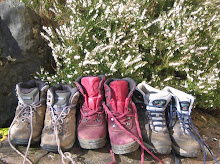
More than 3,000 species of gilled fungi alone have been recorded in North-west Europe, many of which are found on the Isle of Mull. The humid conditions that generally prevail on the island during the Autumn months provide ideal conditions for the various fruiting bodies to appear above ground. The fertile caps of these Common Inkcaps are over-ripe. The bronze bonnets shelter the decaying and deliquescing gills which store the next generation of this remarkable fungi.
Perfect and Purple

From familiar toadstools with a distinctive cap and stem to very different and unusual fungal forms with spines, tubes, pores and wrinkles, the Isle of Mull provides a breeding ground for them all. One of the most attractive gilled mushrooms on Mull is the violet-coloured Amethyst Deceiver. Not only is it a delight to look at, it is also highly edible and is known to stain omelettes purple. We knew of the Goose that laid the Golden Egg, but were previously unaware that on Mull we had the Hen that lays the Purple Eggs!
Spiny yet Soft

Widespread within both broad-leaved and coniferous woodland on Mull are two highly distinctive fungi that have soft and brittle quills instead of gills below their caps. Both Wood and Terracotta Hedgehog fungus are highly prized by mushroom gourmets and are a treasure to stumble across on a fungal foray. The smaller Terracotta Hedgehog is orange in colour, whose spiny underside resembles a mouth overcrowded with teeth.
Pseudo-Baleen and Bolete

Some of the most remarkable of all Mull’s fungi belong to a large group of organisms referred to as ‘Boletes’. These toadstools have a strong mycorrhizal relationship with particular trees and do not possess gills. Instead, like this Brown Birch Bolete, the underside is soft, spongy and porous. The spore-producing layer is contained in tubes, which resemble the baleen plates that hang from the upper jaws of plankton- eating whales, such as the Minke Whale. However, that’s where any resemblance begins and ends.
Honeycombed and Squeezable

The pores of the Larch Bolete, a sticky-capped fungi with an obvious tree association, are reminiscent of a certain honeycomb-centred chocolate bar. However, instead of being crunchy, these pores have a soft and bouncy texture that is satisfying to squeeze and is less likely to give you toothache! The spores that ripen in the tubes drop out of these pores and fall on to the ground or are dispersed by the wind.
Fecund and Fitful

Like the cavernous crater of a mini-volcano, the top of this Common Puffball has burst open, revealing a mass of fertile, olive-coloured spores. Produced in the upper body of the fungus, these spores are released through a vent which develops at the top. The fruitbody relies on rainfall to generate this. When raindrops hit the top of the fungus, spores puff out of the opening, like ash and dust spewing from a volcano, albeit massively reduced in size!



No comments:
Post a Comment